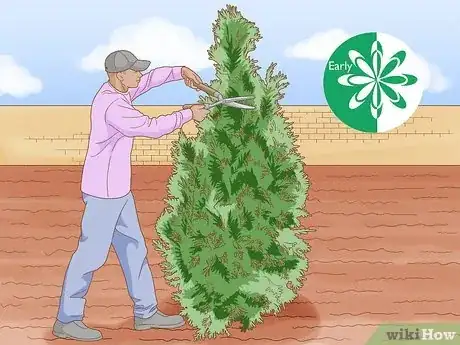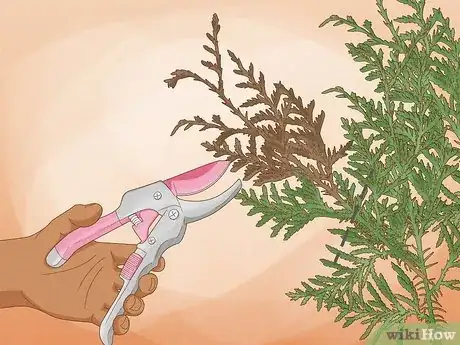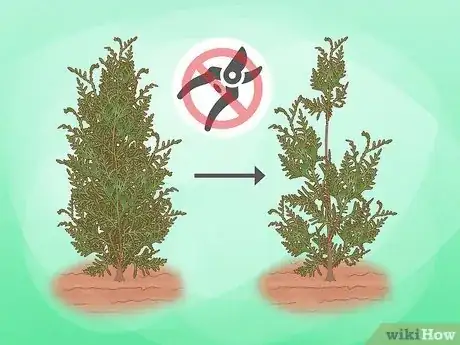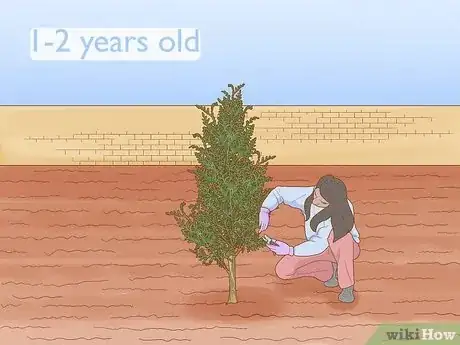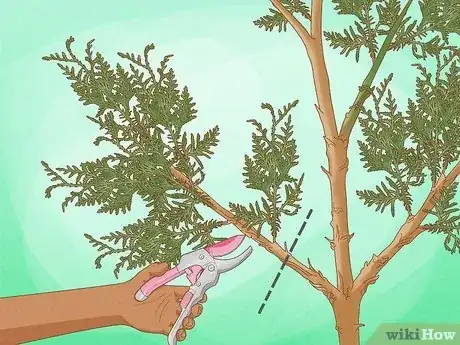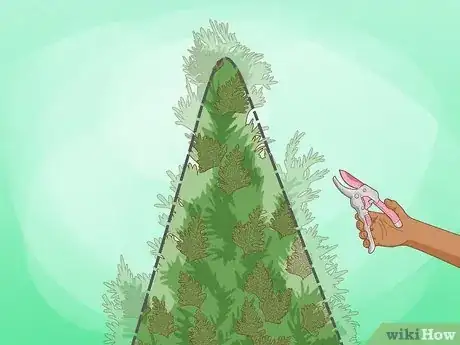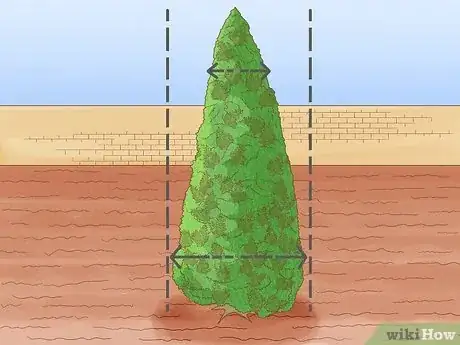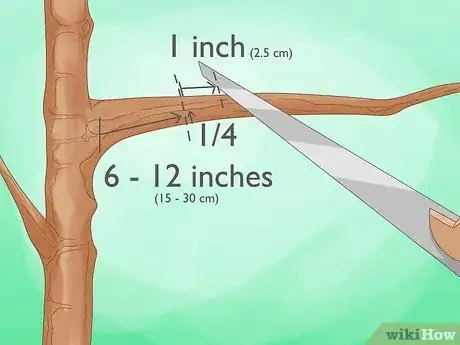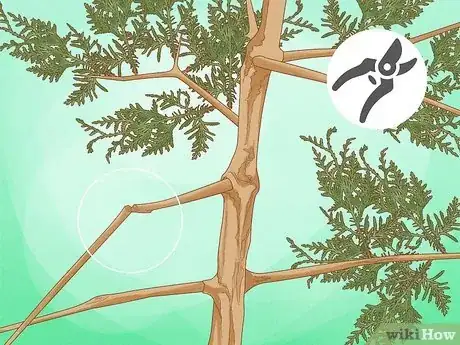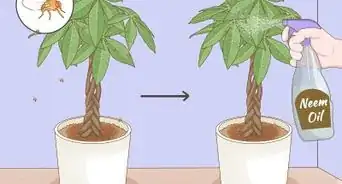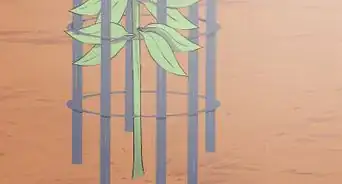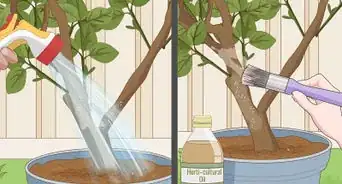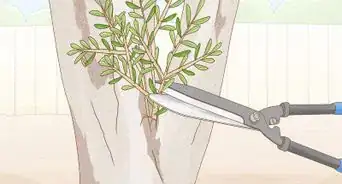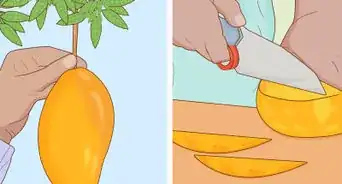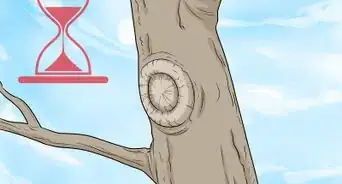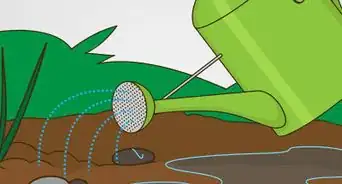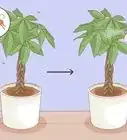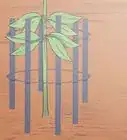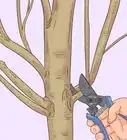This article was co-authored by Lauren Kurtz. Lauren Kurtz is a Naturalist and Horticultural Specialist. Lauren has worked for Aurora, Colorado managing the Water-Wise Garden at Aurora Municipal Center for the Water Conservation Department. She earned a BA in Environmental and Sustainability Studies from Western Michigan University in 2014.
There are 14 references cited in this article, which can be found at the bottom of the page.
This article has been viewed 54,036 times.
Arborvitae are evergreens that do well with enough pruning to help them maintain their natural shape. If you want to help these natural beauties become their best selves, time your pruning well, doing the heaviest pruning in early spring. However, you should also prune any time of year when you come across dead, diseased, or damaged branches. Shape these trees to your liking, though grooming them to their natural shape usually works best. Depending on its cultivar, your arborvitae's natural shape is likely pyramidal, globular, or columnar.
Steps
Timing Your Pruning
-
1Shear in early spring. Early spring is a good time for heavy pruning because new growth hasn't started yet. When new growth does come in, it will hide the cuts you made in the tree.[1]
- To shear the plant, go over the whole plant with your pruning shears. Trim the tips off all of the branches to create a more even shape. Make sure to leave at least 1 shoot at the top of the tree for new growth.
- Pruning shears are scissor-like pruners that have 2 long blades that make them great for shaping your plant. If you need to remove entire branches, use loppers or a small saw.
- The earliest you should prune these trees is mid-March, though it does depend on how early spring comes to your area.[2]
-
2Do light pruning from early spring to mid-summer. These trees continue to grow throughout the summer, so you may want to snip an errant branch here and there. It's fine to perform these cuts throughout the mid-summer.
- Anytime you prune a tree, you can encourage new growth. Therefore, it's best to wait until prime growing season for pruning these trees so you don't encourage it to start growing in winter.[3]
Advertisement -
3Prune troublesome branches anytime they need it. When you see diseased, dead, or damaged branches, trim them right away. Trimming off these branches is better for the health of the plant, as diseases can spread and damaged branches can be a drain on the tree's resources.[4]
-
4Avoid pruning very young arborvitae. When a tree is first getting established, it needs its foliage for growth. If you remove too much of its foliage, you could stunt its growth or even kill it. Prune sparingly on very young arborvitae in the first year or 2 of their life.[5]
- You can trim diseased, broken, or dead branches away if you need to, as well as any branches that rub on each other.
-
5Be more conservative when pruning trees that are over 2 years old. Arborvitae that are a couple of years old are more forgiving of cuts than an old tree. You can cut back into wood that is a year or 2 old, and the tree will likely grow it back. However, in older trees, it's less likely to grow back.[6]
- Arborvitae really don't need much pruning in general, so you should mostly prune to keep the tree's natural shape.
Creating Shapes
-
1Cut down to a lower branch crotch to reduce height. When you want to make your tree shorter, move down to the next place on the main stem where a large branch is growing off of it. Cut the stem or branch with a saw or shears at this point, but only do so if you're cutting into live wood.[7]
- Check to make sure the fronds are growing on the wood that you're leaving behind. If you cut into old wood that isn't growing fronds, the tree will not regrow from that point.[8]
-
2Don't reduce a tree's height by more than 20 percent. Reducing the plant by more than this amount is too much of a shock to the tree. Plus, you run the risk of cutting into old wood, which your tree won't recover from.[9]
-
3Trim the tips of branches to shape the tree. If you want to shape the tree, particularly if you've just trimmed the top, you can cut around the outer edges. Use pruning shears to snip off the outer edges of branches, creating a light shape.[10]
- When shaping the tree, follow its natural shape by snipping off pieces that are sticking out.
-
4Keep the base wider than the top. These evergreens naturally have a wider base. When you're shaping them, try to keep this feature. Doing so allows the bottom of the tree to receive sunlight, as it's not being blocked by the upper branches.[11]
- If you notice you've created a shape that's too straight top-to-bottom, trim a bit more off the top branches.
-
5Prune lightly as old wood will not regrow. With arborvitae, the old wood doesn't bud. Therefore, what you cut won't always regrow. Use a light hand so you don't butcher the tree without it having a way to get its shape back.[12]
- When cutting shoots, never cut them all the way back to old wood.
Pruning Troublesome Branches
-
1Use the 3-branch cut when removing a large limb. This cut allows you to take out a branch without damaging the bark as much. If you don't use this cut, you could rip or tear the bark. Start by making a cut on the underside of the branch 6 to 12 inches (15 to 30 cm) away from the trunk. Cut 1/4 of the way into the branch.[13]
- Make another cut on top, 1 inch (2.5 cm) further out from the trunk than the first cut. The branch may fall off before you finish this cut. You should cut until the limb comes off.
- Cut the stub off at the trunk. Saw from top to bottom just beyond the swollen ring of bark at the trunk.
-
2Cut out dead branches to the stem. When you see brown foliage at the end of the branch, that's an indication it's died. In that case, cut the branch right at the stem with clippers or a saw and pull the branch out.[14]
- Lopping shears are a good choice for this purpose, as they have long handles that give you leverage. However, if the branches are larger than 1 inch (2.5 cm) in diameter, you can use a handsaw or a chainsaw instead.
- Another option is to make the cut at a healthy lateral branch instead of the trunk. A lateral branch is a main branch that grows off the trunk.
-
3Look for diseased branches to prune. Diseased branches also need to be pruned so diseases don't spread to the rest of the tree. When you find a diseased branch, cut it all the way back to the stem or a lateral branch.[15]
- One common disease for this group of trees is needle blight, which results in yellowed or brown needle tips that progresses further down the foliage. They may also look dried out. On the branches, look for black fungal spots that may also curl out from the bark.[16]
- Make sure that you dispose of any diseased branches properly in your trash or curbside yard waste program. Then rake up the needles under the tree and dispose of these as well, as they may contain spores. This will prevent it from spreading.
- It's also best to avoid pruning diseased branches while they're wet because that's when fungal spores are most active.
-
4Prune away damaged branches when they break. If your tree is damaged by a storm or ice, cut away the branches that are damaged. Prune them back to the stem or a lateral branch within the tree.[17]
- Damaged branches drain the tree's resources and won't provide new growth.
References
- ↑ http://www.mortonarb.org/trees-plants/tree-and-plant-advice/horticulture-care/pruning-evergreens
- ↑ http://web.extension.illinois.edu/state/newsdetail.cfm?NewsID=10325
- ↑ https://hort.uwex.edu/articles/pruning-evergreens/
- ↑ http://www.mortonarb.org/trees-plants/tree-and-plant-advice/horticulture-care/pruning-evergreens
- ↑ https://www.thisoldhouse.com/how-to/how-to-prune-small-trees-and-shrubs
- ↑ https://books.google.com/books?id=5WYKAAAAQBAJ&pg=PT303&lpg=PT303&dq=correcting+growth+defects+in+arborvitae&source=bl&ots=yqGNco5Hp8&sig=4DXYMdvKiea7ZB4FA2XNDNFClnE&hl=en&sa=X&ved=0ahUKEwjVxt_HlqraAhWi4IMKHRgADekQ6AEISzAE#v=onepage&q=%20arborvitae&f=false
- ↑ http://www.mortonarb.org/trees-plants/tree-and-plant-advice/horticulture-care/pruning-evergreens
- ↑ https://www.thisoldhouse.com/how-to/how-to-prune-small-trees-and-shrubs
- ↑ http://www.mortonarb.org/trees-plants/tree-and-plant-advice/horticulture-care/pruning-evergreens
- ↑ http://www.mortonarb.org/trees-plants/tree-and-plant-advice/horticulture-care/pruning-evergreens
- ↑ https://hort.uwex.edu/articles/pruning-evergreens/
- ↑ http://ag.umass.edu/fact-sheets/pruning-needled-evergreens
- ↑ https://www.thisoldhouse.com/how-to/how-to-prune-small-trees-and-shrubs
- ↑ http://ag.umass.edu/fact-sheets/pruning-needled-evergreens
- ↑ http://ag.umass.edu/fact-sheets/pruning-needled-evergreens
- ↑ http://ag.umass.edu/landscape/fact-sheets/arborvitae-needle-blight
- ↑ http://www.mortonarb.org/trees-plants/tree-and-plant-advice/horticulture-care/pruning-evergreens
